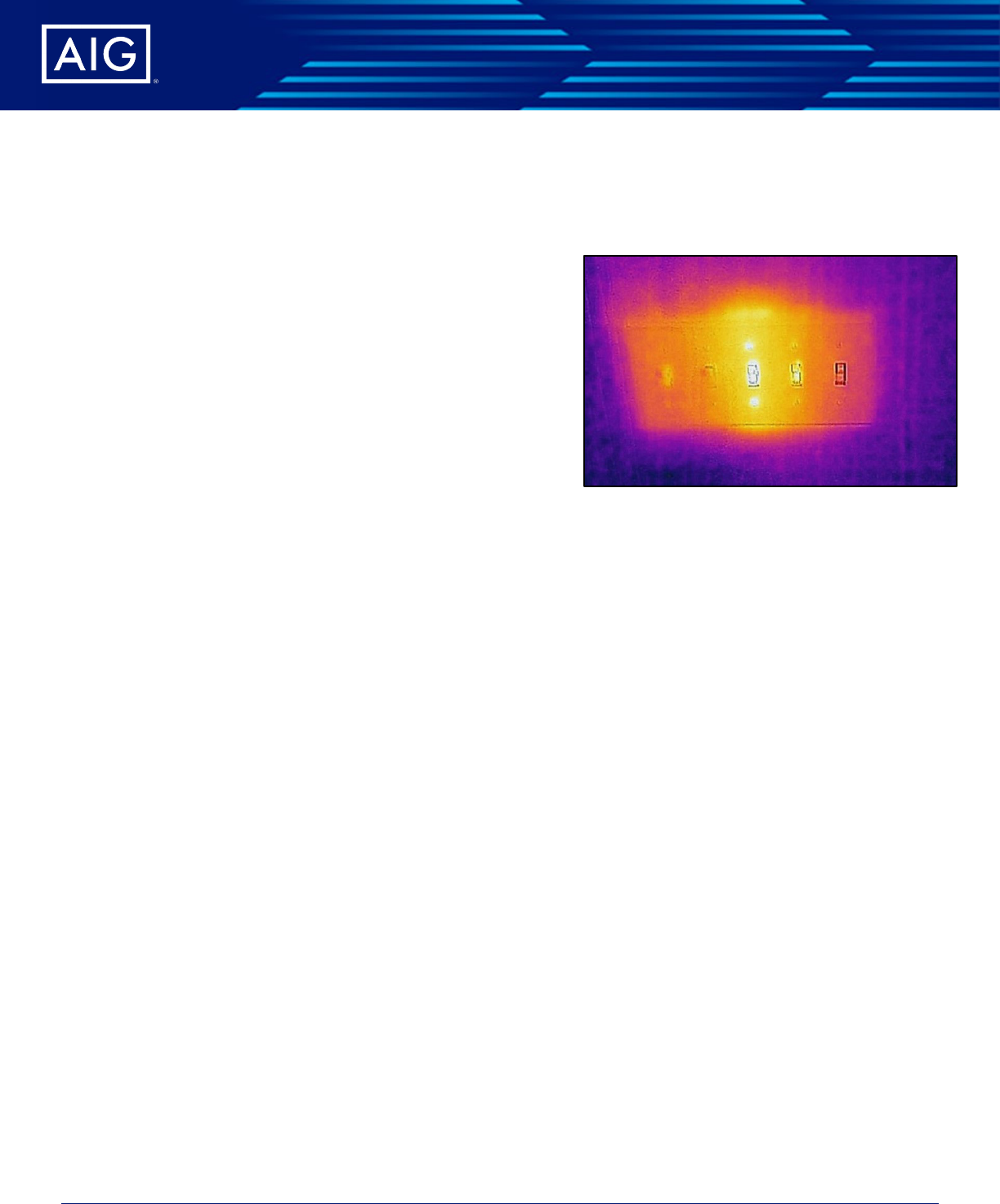
AIG Insight | 02 Jun, 2022
1 of 2
Property Risk Engineering Insight
Insight: Thermography
Recognizing the Risk
Overheating electrical and mechanical systems are a major cause of
fires each year globally that result in significant property loss and
business interruption. While the causes of overheating in these systems
can vary, a single act of loss prevention can be critical- implementation
of written electrical and mechanical systems preventative maintenance
programs anchored by regular infrared thermography (IR) inspections.
NFPA 70B, which AIG recommends for basic electrical systems
preventive maintenance guidance, sums up the concern and
importance of this relatively inexpensive and an often-overlooked
critical part of every comprehensive property risk management
program:
"A well-administered electrical preventive maintenance (EPM) program
reduces accidents, saves lives, and minimizes costly breakdowns and unplanned shutdowns of production equipment.
Impending troubles can be identified — and solutions applied — before they become major problems requiring more
expensive, time-consuming solutions.”
Electrical systems can overheat for a variety of reasons including component fatigue, contamination and manufacturing
defects. Other typical causes are loose connections and overloading. In such cases, slight temperature variances will build-
up in areas called “hot spots” flagging the need for investigation. Infrared cameras allow thermographers to see and identify
these imbalances prior to a potential critical breakdown. Thermography is also recommended for critical mechanical
systems, such as motor and conveyor bearings that can also heat up from added friction or loads. A simple example is
shown in the photo where a light switch is giving off excess heat while being in the on position.
Controlling the Hazard
Controlling the risk of this hazard begins conducting IR surveys at regular intervals utilizing trained thermographers that
provide meaningful reports and recommendations. Areas included in these surveys should include areas per NFPA 70B
and critical mechanical systems include, but are not limited to:
• Electrical switch gear, breakers, bus connections and contacts
• Transformer bushing connections and cooling fins
• Motor and generator connections, windings, feeders and excitors
• Motors, line shafts and process equipment bearings
• Friction in drive gears and drive belts
• Refractory systems (boilers, kilns, molten material containment, etc.)
• Steam traps and piping insulation
Typical problems detected during IR surveys include loose connections faulty equipment, overloaded circuits, and
unbalanced Loads. Surveys should be conducted as part of a regular preventative maintenance program with timely reviews
of reports and taking action to correct noted issues.

Insight: Thermography
AIG Insight | 02 Jun, 2022
2 of 2
While surveys may require panel and specific equipment access, thermal imaging equipment is performed through non-
contact means and while equipment is under load/operation- thus surveys can normally be performed without interuption to
production operations or the equipment that is under review.
Most customers that implement IR survey programs find incredible value- not only in discovered potential risk reduction but
also in general cost savings due to increased systems efficiency.
References & Resources
NFPA 70B: Recommended Practice for Electrical Equipment Maintenance
*While NFPA documents are the global standard used by AIG, international equivalents may be acceptable.
For more information, contact your local AIG Risk Engineer.
T
he information, suggestions and recommendations contained herein are for general informational purposes only. This information has been compiled
from sources believed to be reliable. Risk Consulting Services do not address every possible loss potential, law, rule, regulation, practice or procedure. No
warranty, guarantee, or representation, either expressed or implied, is made as to the correctness or sufficiency of any such service. Reliance upon, or
compliance with, any recommendation in no way guarantees any result, including without limitation the fulfillment of your obligations under your insurance
policy or as may otherwise be required by any laws, rules or regulations. No responsibility is assumed for the discovery and/or elimination of any hazards
that could cause accidents, injury or damage. The information contained herein should not be construed as financial, accounting, tax or legal advice and
does not create an attorney-client relationship.
This document is not intended to replace any recommendations from your equipment manufacturers. If you are unsure about any particular testing or
maintenance procedure, please contact the manufacturer or your equipment service representative.
American International Group, Inc. (AIG) is a leading global insurance organization. AIG member companies provide a wide range of property casualty
insurance, life insurance, retirement solutions and other financial services to customers in approximately 70 countries and jurisdictions. These diverse
offerings include products and services that help businesses and individuals protect their assets, manage risks and provide for retirement security. AIG
common stock is listed on the New York Stock Exchange.
Additional information about AIG can be found at www.aig.com | YouTube: www.youtube.com/aig | Twitter: @AIGinsurance www.twitter.com/AIGinsurance
| LinkedIn: www.linkedin.com/company/aig. These references with additional information about AIG have been provided as a convenience, and the
information contained on such websites is not incorporated by reference herein.
AIG is the marketing name for the worldwide property-casualty, life and retirement and general insurance operations of American International Group, Inc.
For additional information, please visit our website at www.aig.com. All products and services are written or provided by subsidiaries or affiliates of
American International Group, Inc. Products or services may not be available in all countries and jurisdictions, and coverage is subject to underwriting
requirements and actual policy language. Non-insurance products and services may be provided by independent third parties. Certain property-casualty
coverages may be provided by a surplus lines insurer. Surplus lines insurers do not generally participate in state guaranty funds, and insureds are therefore
not protected by such funds.
Copyright © American International Group, Inc. All rights reserved.
